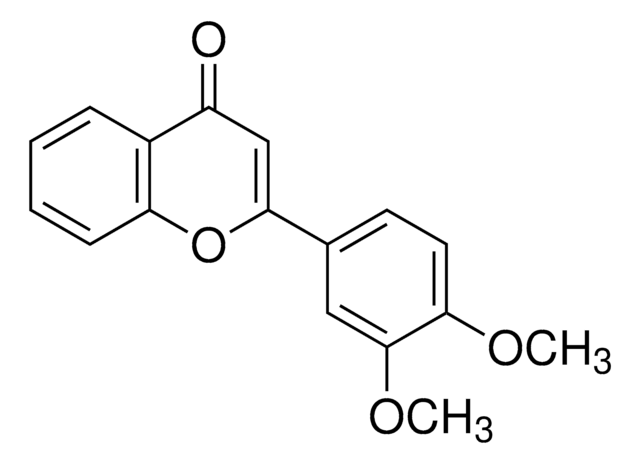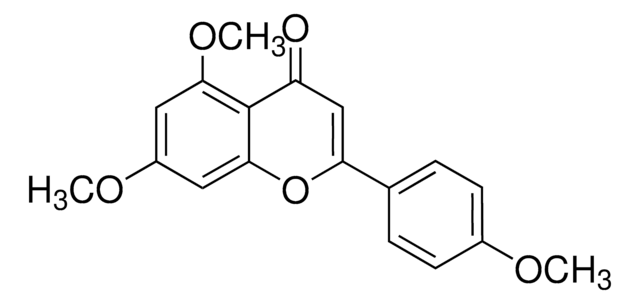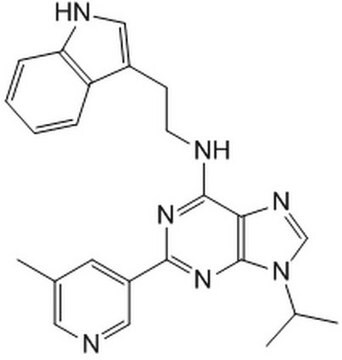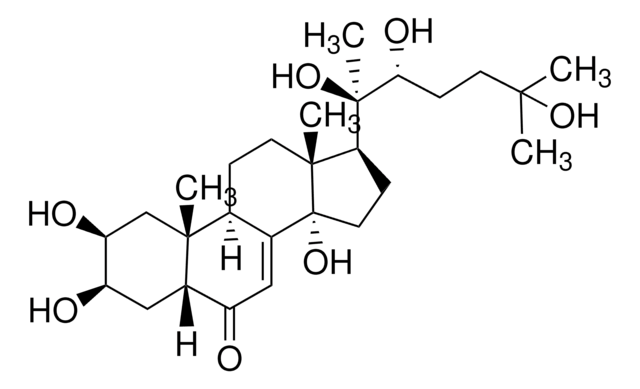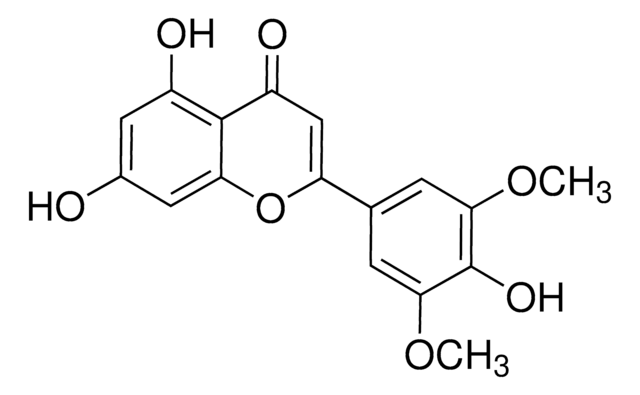추천 제품
Quality Level
분석
≥98% (HPLC)
양식
powder
저장 조건
desiccated
protect from light
색상
yellow
solubility
DMSO: >5 mg/mL
저장 온도
room temp
SMILES string
COc1ccc(c(OC)c1)C2=CC(=O)c3cc(OC)ccc3O2
InChI
1S/C18H16O5/c1-20-11-5-7-16-14(8-11)15(19)10-18(23-16)13-6-4-12(21-2)9-17(13)22-3/h4-10H,1-3H3
InChI key
WUWFDVDASNSUKP-UHFFFAOYSA-N
생화학적/생리학적 작용
6, 2′, 4′-trimethoxyflavone is a selective aryl hydrocarbon receptor (AHR) antagonist with no partial agonist activity. The role of the transcription factor aryl hydrocarbon receptor (AHR) in biology is still under evaluation and has expanded beyond that of a xenobiotic sensor and regulator of detoxification. Inhibition of AHR activity by antagonists could result in anti-inflammatory actions. 6, 2′, 4′-trimethoxyflavone (TMF) is a pure AHR antagonist. The compound compete with agonists, such as 2, 3, 7, 8-tetrachlorodibenzo-p-dioxin (TCDD) and benzo[a]pyrene (B[a]P), thus effectively inhibiting AHRmediated transactivation of a heterologous reporter and endogenous targets e.g. CYP1A1. TMF also exhibits no species or promoter dependency with regard to AHR antagonism. Thus it represents an improved tool allowing for more precise dissection of AHR function.
The AHR along with immune functions, is also associated with endocrine processes and cancer development.
제조 메모
6, 2′, 4′-trimethoxyflavone is soluble in DMSO at a concentration that is greater than 5 mg/ml.
신호어
Danger
유해 및 위험 성명서
Hazard Classifications
Acute Tox. 3 Oral
Storage Class Code
6.1C - Combustible acute toxic Cat.3 / toxic compounds or compounds which causing chronic effects
WGK
WGK 3
Flash Point (°F)
Not applicable
Flash Point (°C)
Not applicable
Róisín O'Flaherty et al.
Journal of proteome research, 16(11), 4237-4243 (2017-09-28)
Here we report evidence that new aminoquinoline N-glycan fluorescent labels interfere with the release of core α(1-6) fucose from N-glycans by bovine kidney α-l-fucosidase (BKF). BKF is a commonly employed exoglycosidase for core α(1-6) fucose determination. Molecular simulations of the
Noël J Diepens et al.
Environmental science & technology, 52(15), 8510-8520 (2018-06-22)
We present a generic theoretical model (MICROWEB) that simulates the transfer of microplastics and hydrophobic organic chemicals (HOC) in food webs. We implemented the model for an Arctic case comprised of nine species including Atlantic cod and polar bear as
Antagonism of aryl hydrocarbon receptor signaling by 6, 2?, 4?-trimethoxyflavone
Murray IA, et al.
Journal of Pharmacology and Experimental Therapeutics, 332(1), 135-144 (2010)
Runxia Sun et al.
Environmental pollution (Barking, Essex : 1987), 222, 165-174 (2017-01-04)
Short chain chlorinated paraffins (SCCPs) are under review for inclusion into the Stockholm Convention on Persistent Organic Pollutants. However, limited information is available on their bioaccumulation and biomagnification in ecosystems, which is hindering evaluation of their ecological and health risks.
Joseph Shailender et al.
Drug development and industrial pharmacy, 44(7), 1109-1119 (2018-02-08)
Design chitosan based nanoparticles for tenofovir disoproxil fumarate (TDF) with the purpose of enhancing its oral absorption. TDF is a prodrug that has limited intestinal absorption because of its susceptibility to gut wall esterases. Hence, design of chitosan based polymeric
자사의 과학자팀은 생명 과학, 재료 과학, 화학 합성, 크로마토그래피, 분석 및 기타 많은 영역을 포함한 모든 과학 분야에 경험이 있습니다..
고객지원팀으로 연락바랍니다.